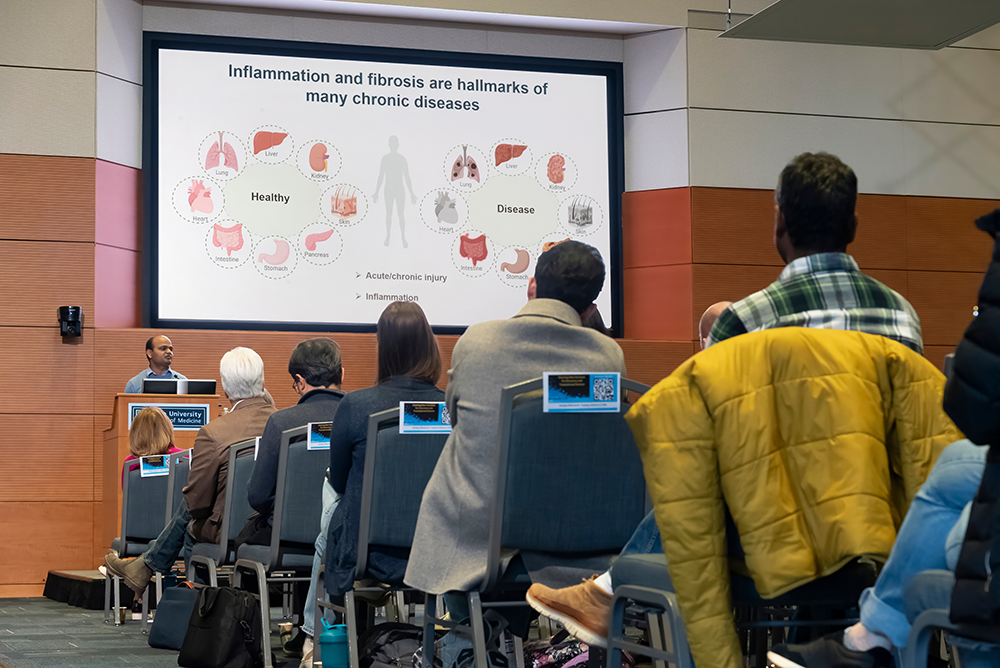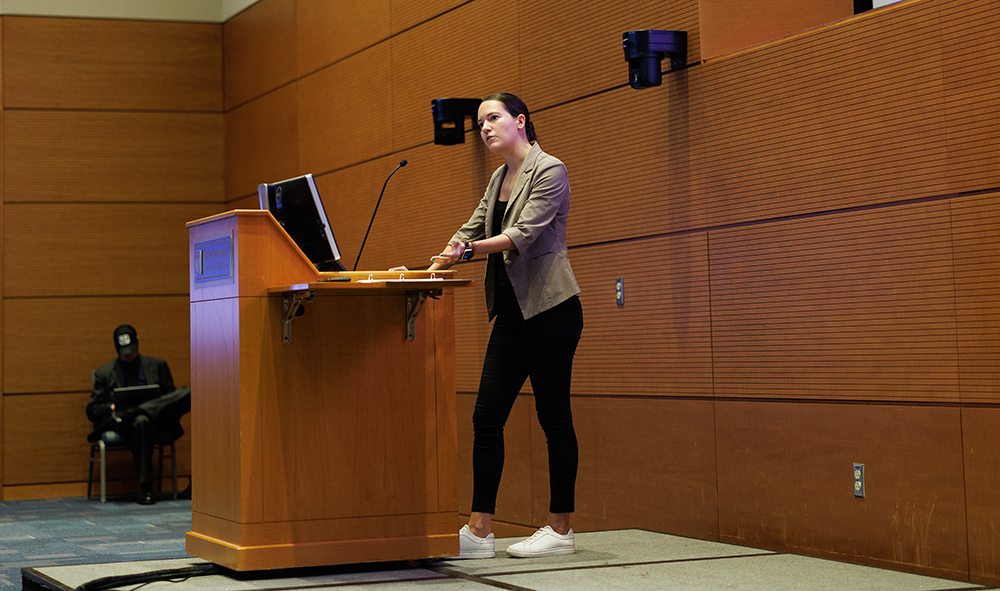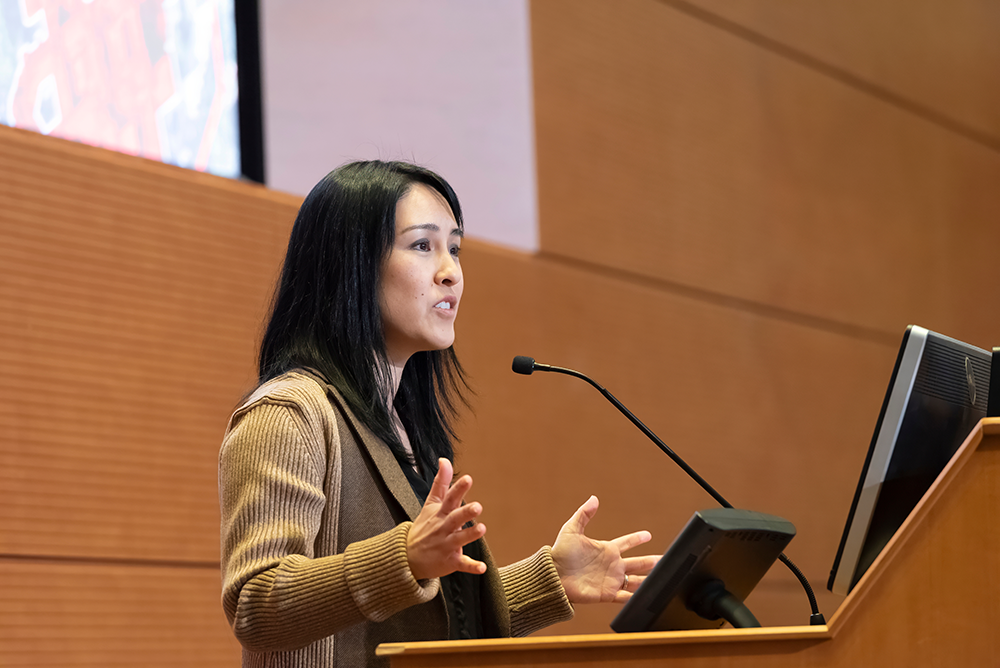
Symposium Highlights Cutting-Edge Research
Brain implants that can banish the crippling flashbacks associated with severe post-traumatic stress disorder. Robotics that dramatically speed up evolution, enabling scientists to guide proteins and other molecules to evolve toward therapeutic applications. Artificial intelligence that can identify sepsis almost a full day before it becomes otherwise detectable.
These were just a few glimpses of the cutting-edge biomedical science on display at the "Charting New Horizons for Discovery & Translational Science" research symposium at the Trent Semans Center for Health Education.
Over the course of a day and a half, nearly two dozen Duke scientists from a wide range of disciplines shared research that spanned the spectrum from discovery science, such as mitochondrial dysregulation and neurocircuitry, to translational applications, such as repurposing “failed” drugs for surprising new uses.
“As a research-intensive institution, we are moving discovery to the bedside with innovations that cannot be done anywhere else,” said Mary E. Klotman, MD, executive vice president for health affairs at Duke University and dean of the School of Medicine in her welcoming remarks. “What our researchers are doing exemplifies 21st-century science and health care. We are harnessing these tools — discovery science, AI, technology, translation — to move the needle on some of the biggest challenges in biomedical science.”
Colin Duckett, PhD, professor of pathology and executive vice dean for basic and preclinical science, coordinated and led the symposium, which was organized into five thematic sessions.
The first day’s lineup highlighted “Next Generation Therapeutics”; “Modeling Biology: Molecules to Populations”; “Decoding and Modulating the Brain”; and “Immunoengineering to Rebalance Inflammation and Regeneration.” The second day’s session culminated in a “Translational Science Accelerator: Bridging Discovery and Clinical Impact.” A poster session allowed additional scientists the opportunity to share their research.
Snapshots from the Symposium

Purushothama Rao Tata, PhD, associate professor of cell biology, studies the role of immune response and inflammation in tissue regeneration. Many organisms are capable of regenerating some or even all of their tissues after injury or disease: severed sections of planaria flatworms will regenerate into whole new planaria, newts can regenerate lost limbs, and reindeer regrow their antlers. “Some tissues can regenerate, and others can’t,” Tata said. “What’s the difference?”
One key difference is the type of inflammatory response that results from damage to different types of tissues. Tata has shed important new light into how immune response plays a critical role in how lung tissue heals, and how that response might be modulated to enhance tissue regeneration.

Emma Chory, PhD, a Duke Science and Technology Scholar and one of several speakers who work at the intersection of medicine and engineering, shared her research in the field of directed evolution, which recreates the evolutionary process of mutation, selection, and replication in the lab. Directed evolution provides insights into the molecular mutations that drive diseases like cancer — and by selecting for desirable mutations, researchers can guide molecules to evolve in ways to combat disease. Chory’s lab has developed a robotic platform that enables them to perform directed evolution processes at very large scales, providing vastly more data at a faster pace.
“There is a critical need for systems that let us study, at the fundamental level, how proteins, viruses, and other molecules adapt, and hopefully how we can use these insights to develop better therapies,” said Chory.

Rishi Kamaleswaran, PhD, associate professor of surgery, shared the work his lab is doing to develop AI and machine learning methods that monitor multiple vital signs continuously in real time to detect the onset of serious conditions, such as sepsis, long before observable symptoms present.
“In these cases, you have a patient who starts deteriorating and progressively gets worse until they cross into a state of distress that is humanly visible,” he said. “But by the time that person enters that state of distress, there has already been some level of organ injury, and bringing that person back to state of health is nearly impossible in many cases.”
New technologies can detect changes in heart rate and other processes that indicate incipient sepsis almost 24 hours before they become otherwise apparent, offering the opportunity for earlier intervention.

Nanthia Suthana, PhD, a neuroscientist and Duke Science and Technology Scholar who recently came to Duke from the University of California-Los Angeles, shared her pioneering research using deep brain stimulation (DBS) to treat memory-related conditions such as post-traumatic stress disorder and Alzheimer's disease.
Her team found that specific brain wave oscillations were associated with memory spikes during key recall moments and negative memory flashbacks, offering a biomarker for intervention. In a clinical trial using neural implants and wireless interface, her team was able to deliver targeted DBS that resulted in significant reductions and even remission of symptoms in patients with treatment-resistant PTSD.
“We're hopeful that bringing this technology to Duke and taking advantage of the unique position that is here in terms of medicine, neuroengineering, and neuroscience will help us expand this platform to other disorders, and also help understand the neuroscientific mechanisms,” Suthana said. “Duke is in a unique position to drive innovation.”
David Hart is editorial director in the Duke School of Medicine Office of Strategic Communications.
Photos by Eamon Queeney assistant director of multimedia and creative in the Office of Strategic Communications.
